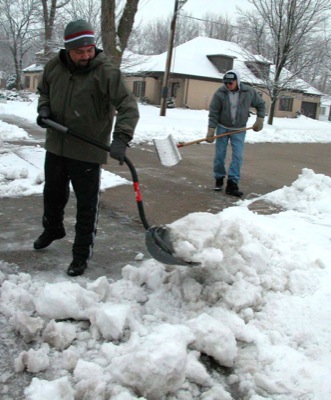Tuesday, February 26th, 2008
$1 million offered to area farmers in subwatersheds
By Nancy Allen

Submitted Photo
Farmers in the Barnes Creek and Chickasaw Creek subwatersheds in Mercer and Auglaize counties can apply for $1 million in USDA conservation funds to plant buffer areas and winter cover crops.
The USDA has set aside $1 million to help with water cleanup efforts in the Grand Lake Watershed.
The money will be available to farmers in the Chickasaw Creek and Barnes Creek subwatersheds to plant buffer strips and winter cover crops to help filter out sediment and nutrients before they get into waterways. The farmers also will be allowed to harvest hay from the buffer strips.
The Chickasaw and Barnes creek subwatersheds are made of 20,000 acres located in Mercer and Auglaize counties, which are part of 71,862-acre Grand Lake Watershed, and the 13,500-acre lake.
Producers can start applying today for the funding, and the deadline to sign up is March 14, the day before the existing 2002 Farm Bill expires. Priority will be given to applications received by March 7.
A mailing is being sent out today to all landowners in the qualifying areas, and two information meetings will he held this week and next.
The $1 million award was announced Monday in a press release by Congressman John Boehner, R-West Chester, and Sen. Sherrod Brown, D-Ohio. Both legislators have been working for some time to steer funding to the Grand Lake Watershed, which has been deemed one of the most degraded in the state.
Boehner's press secretary Jessica Towhey said the funding is not an earmark because the money "was allocated after careful review by the Department of Agriculture's Natural Resources Conservation Service (NRCS) based on the merits of the project." Boehner does not support earmarks.
The funds for the demonstration project, as it is being called, are coming from the nationwide pot of USDA conservation money available in the Environmental Quality Incentives Program (EQIP), said Jim Will, district conservationist for Mercer County. The EQIP funding was authorized in the 2002 Farm Bill.
A portion of the money will be used to monitor water quality in the area. Will said NRCS will use existing water quality data and new data to determine a baseline measurement of the impairments in both subwatersheds. A monitoring station will be placed in the area of the two subwatersheds to continually gather water quality data so officials can compare before and after data.
Will said the subwatersheds were chosen for the project because the area includes both counties and contains a high concentration of livestock. Excess sediment and nutrients, particularly phosphorous, are the main contributors to poor water quality in the Grand Lake Watershed, with most of it coming from farmland runoff, Ohio EPA water quality testing has shown.
"Roughly 40 percent of the total animal units in the entire Grand Lake Watershed are in these two subwatersheds," Will said. "In that area there are four to five turkey operations, 10 layer hen operations, 25 dairies, 25 hog operations and about 40 guys raising beef cattle."
Producers will be able to plant the buffer strips along existing grass waterways and filter strips and along roadside ditches, Will said.
The fact that producers will be able to harvest the hay from the buffer strips should make the program very attractive. Existing USDA conservation programs do not allow harvesting of hay from filter strips.
Because most producers already have made their planting decisions for this growing season, producers signing up for buffer strips would not have to plant them until spring of 2009.
Winter cover crops could go in this fall. The extensive, burrowing root systems of winter cover crops help take up nutrients from manure spread on farm ground and also help aerate the soil.
Most of the sediment and nutrients entering the watershed and lake comes in the fall and winter months, after crops have been harvested and manure is spread on bare farm ground.
"This is a huge, huge project," Will said. "With what we are offering, it should make an improvement (in water quality)."
Will said there are no major requirements for producers to apply, but applicants who have existing Comprehensive Nutrient Management Plans and Nutrient Management Plans will be ranked higher. Those with land closer to Grand Lake also will garner more points.
"Basically if you are farming out there or own land out there, you will be eligible," Will said.
Info meeting:
What: Two informational meetings on $1 million in USDA funding available for producers with land in Chickasaw and Barnes Creek subwatersheds in Mercer and Auglaize counties.
When: 1:30 p.m. Friday at Precious Blood Catholic Church, Chickasaw, and 7:30 p.m. Monday in the second floor OSU Extension meeting room, Mercer County Central Services Building, Celina.

